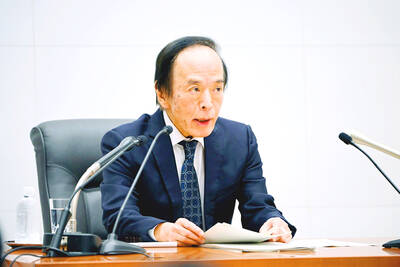South Korea yesterday announced plans to spend an extra 4.9 trillion won (US$3.5 billion) this year to create 550,000 new jobs as it teeters on the edge of a recession brought on by the global slump.
The decision was reached at a special presidential council meeting on the economic crisis, the presidential office said. The money will come from a supplementary budget to be unveiled next week.
Media reports and officials say the government is likely to ask parliament to approve an extra budget of around 30 trillion won.
The country’s export-driven economy is on the brink of its first recession since 1998. The official unemployment rate rose to 3.9 percent last month, the highest in almost four years.
The number of people employed fell by 142,000 year-on-year, the largest reduction since September 2003.
South Korean President Lee Myung-bak called for all-out efforts to save or create jobs.
“The government’s goal this year is to create jobs because many people talk about social welfare, but the best welfare the government can provide is a job,” he told the meeting.
“The largest goal of the supplementary budget is first to create jobs and second to create jobs,” Yonhap news agency quoted him as saying.
These must first go to people who are the sole breadwinners in a family, he said, stressing that work gives people confidence and builds the base for economic recovery.
The country’s biggest business and union groups have already announced what Lee has called “historic, unprecedented measures” to save jobs — including wage cuts and job-sharing.
The spending announced yesterday amounts to roughly 2.9 trillion won for direct job creation, 500 billion won for encouraging job-sharing measures, 158 billion won for training and about 1.6 trillion won for measures to promote new employment and support the poor.
South Korean Finance Minister Yoon Jeung-hyun has said the economy will likely contract 2 percent this year and lose 200,000 jobs.
Daniel Melser, a senior economist with Moody’s Economy.com, called this figure optimistic and said the export-driven economy is likely to shed at least half a million jobs over the course of this year.
He said yesterday’s program was unlikely to reach its job creation target.
“Nevertheless, if the money is appropriately directed it will help to make somewhat of a dent in Korea’s lengthening unemployment queues — though a smaller dent than the half-million jobs which is hoped for,” Melser wrote in a commentary.
The collapse in foreign demand for South Korea’s exports had hit manufacturing very hard, with the finance and construction sectors also feeling the brunt of the crisis, he said.

Taiwan Semiconductor Manufacturing Co (TSMC, 台積電) last week recorded an increase in the number of shareholders to the highest in almost eight months, despite its share price falling 3.38 percent from the previous week, Taiwan Stock Exchange data released on Saturday showed. As of Friday, TSMC had 1.88 million shareholders, the most since the week of April 25 and an increase of 31,870 from the previous week, the data showed. The number of shareholders jumped despite a drop of NT$50 (US$1.59), or 3.38 percent, in TSMC’s share price from a week earlier to NT$1,430, as investors took profits from their earlier gains

In a high-security Shenzhen laboratory, Chinese scientists have built what Washington has spent years trying to prevent: a prototype of a machine capable of producing the cutting-edge semiconductor chips that power artificial intelligence (AI), smartphones and weapons central to Western military dominance, Reuters has learned. Completed early this year and undergoing testing, the prototype fills nearly an entire factory floor. It was built by a team of former engineers from Dutch semiconductor giant ASML who reverse-engineered the company’s extreme ultraviolet lithography (EUV) machines, according to two people with knowledge of the project. EUV machines sit at the heart of a technological Cold

TAIWAN VALUE CHAIN: Foxtron is to fully own Luxgen following the transaction and it plans to launch a new electric model, the Foxtron Bria, in Taiwan next year Yulon Motor Co (裕隆汽車) yesterday said that its board of directors approved the disposal of its electric vehicle (EV) unit, Luxgen Motor Co (納智捷汽車), to Foxtron Vehicle Technologies Co (鴻華先進) for NT$787.6 million (US$24.98 million). Foxtron, a half-half joint venture between Yulon affiliate Hua-Chuang Automobile Information Technical Center Co (華創車電) and Hon Hai Precision Industry Co (鴻海精密), expects to wrap up the deal in the first quarter of next year. Foxtron would fully own Luxgen following the transaction, including five car distributing companies, outlets and all employees. The deal is subject to the approval of the Fair Trade Commission, Foxtron said. “Foxtron will be

INFLATION CONSIDERATION: The BOJ governor said that it would ‘keep making appropriate decisions’ and would adjust depending on the economy and prices The Bank of Japan (BOJ) yesterday raised its benchmark interest rate to the highest in 30 years and said more increases are in the pipeline if conditions allow, in a sign of growing conviction that it can attain the stable inflation target it has pursued for more than a decade. Bank of Japan Governor Kazuo Ueda’s policy board increased the rate by 0.2 percentage points to 0.75 percent, in a unanimous decision, the bank said in a statement. The central bank cited the rising likelihood of its economic outlook being realized. The rate change was expected by all 50 economists surveyed by Bloomberg. The